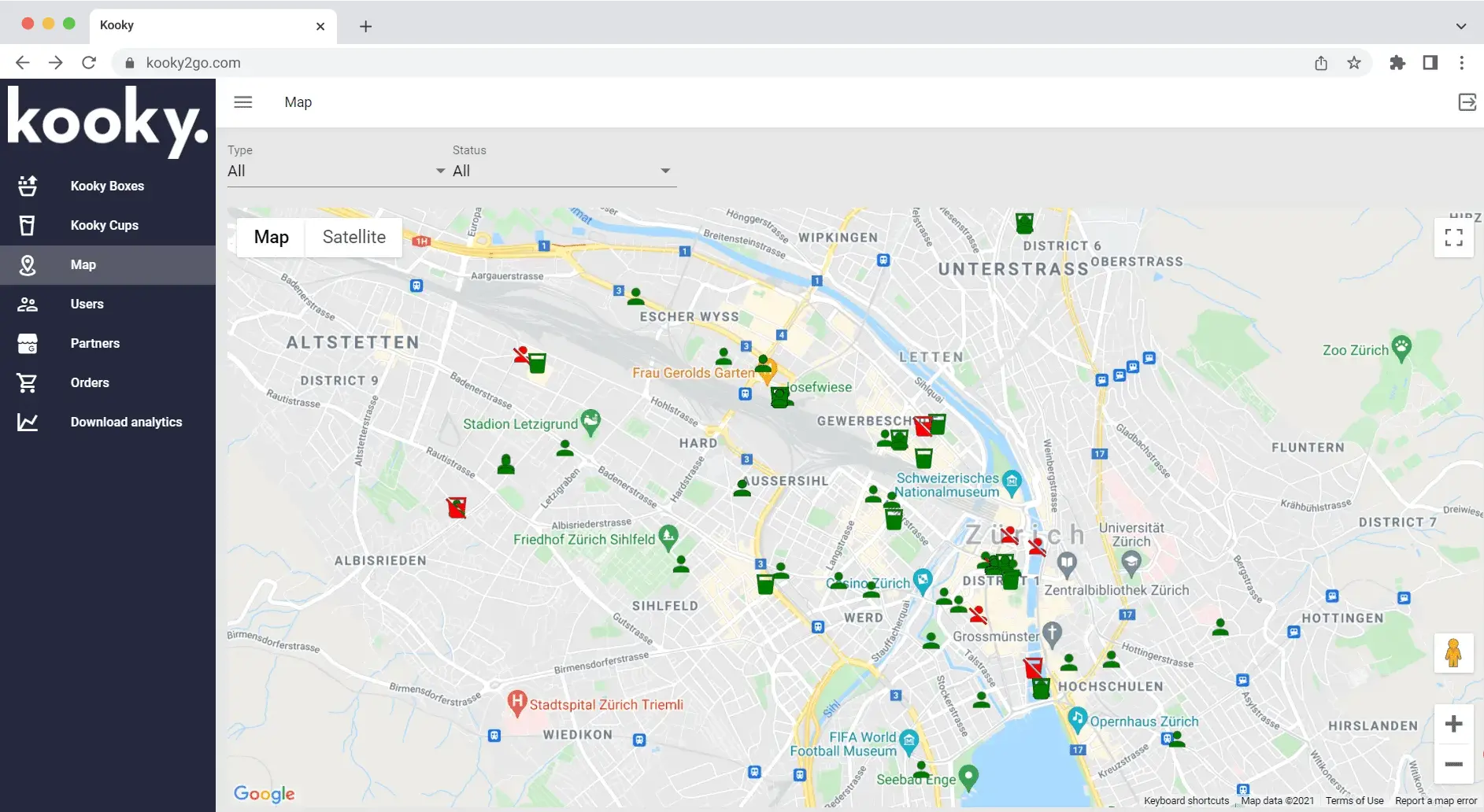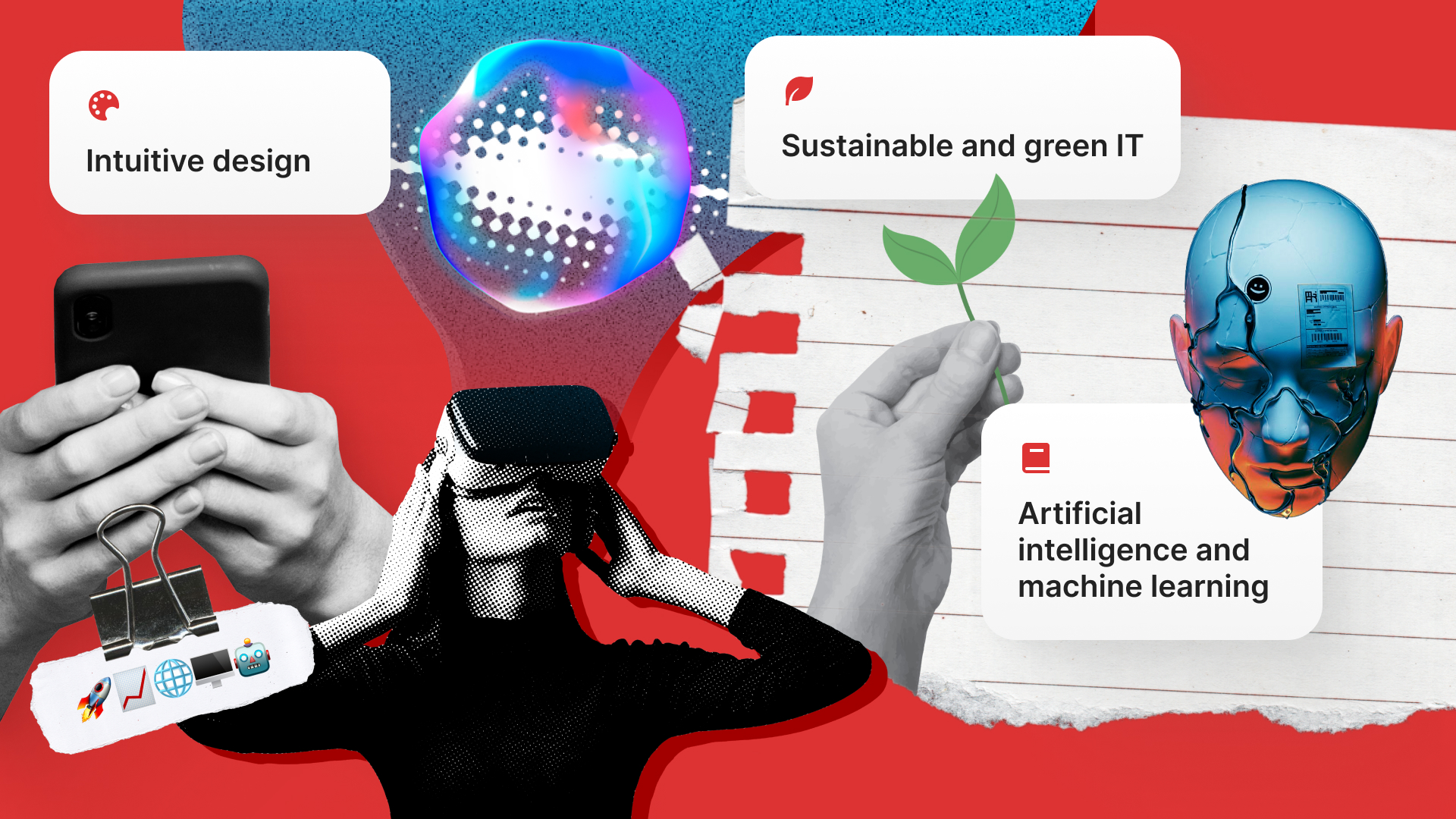The previous year was a banger for digital transformation as companies finally adopted AI, chatbots, and robotic process automation to propel efficiency to unprecedented heights.
This year takes it even further by offering trends in digital transformation that can apply to businesses of different sizes and niches.
Digital Transformation Trends 2024: what to expect
We came up with our top 10 digital transformation trends that promise to reduce operating costs by 30%, save money on marketing campaigns by leveraging data solutions, and get investors to direct funds toward your businesses. In this blog, we will discuss the significance of each trend for the competitive advantage it brings for both businesses and consumers, as well as the challenges of implementing digital transformation strategies.
Hyper-automation
According to Gartner, by 2025, hyper-automation will become a mainstream technology, with 70% of enterprises adopting it in some form. Just as it sounds, hyper-automation is an approach that enables companies to automate as many processes as possible. Hyperautomation relies on technology such as robotic process automation (RPA), low-code application platforms (LCAP), artificial intelligence (AI), chatbots, and virtual assistants. The good news is that this process-agnostic software, such as RPA, LCAP, and AI, can be used in any organization across multiple IT and business use cases.
Big businesses like Walmart are pioneers in showing how to handle this trend in digital transformation. Retail corporations utilize AI-enhanced data analytics to forecast demand and optimize inventory. The company analyzes vast amounts of data, including historical sales data, weather patterns, seasonal trends, and local events, to predict customer demand accurately. As a result, Walmart optimizes inventory levels, reduces stockouts, and minimizes excess inventory. They use a hyper-automation philosophy to ensure they don’t run out of burger buns before your favorite holiday and don’t waste money on carrying and stocking too much.
Hyper-automation can sound hyper-scary, probably stopping you from incorporating these practices into your company. But let’s ditch the FOMO together. If you want to start hyper-automating but are too overwhelmed by information, or maybe you already know your growth points and want to learn a solution, allow us to help. Our certified BAs will dive deep into your daily operations to understand your challenges and the value we can create through technology. We’ll provide you with a custom hyper-automation strategy that is feasible and measurable.
Personalization
Allow us to quote a billionaire, Rihana, who said: You need to make your customers feel like they are “the only girl in the world.” So, without further ado, we are spoiling the next digital business trend, also known as personalization. Deliver personalized interactions at every touchpoint throughout the customer journey by leveraging killer data analytics.
Personalized experiences encourage frequent and meaningful interactions, leading to higher customer retention and happy leads. Learn how your customers change their behaviors in real time. And no, we are not talking about stalking them. Utilizing real-time data analytics enables businesses to respond swiftly to changes in customer behavior. This agility helps you stay relevant and competitive.
So where is the proof? In fact, brands leveraging advanced digital personalization tools see revenue jump by 6% to 10% faster. Consider how Amazon is handling this trend in digital transformation. Through AI and machine learning, Amazon’s recommendation engine sifts through customer behavior, purchase history, and browsing patterns to deliver personalized product suggestions. This savvy approach has proven immensely beneficial, with reports indicating that a significant 35% of Amazon’s revenue is attributed to its recommendation engine.
Thanks to advancements in technology like big data analytics tools, businesses are now able to gather vast amounts of information about their customers. Find out everything from basic demographic information to detailed behavioral insights, such as what products and services they’ve purchased and what online interactions they’ve had with the organization’s website or social media accounts.
Take, for example, our client, the fashion giant Justin Alexander, known for its exquisite bridal wear. The brand’s challenge was to merge four separate websites into a unified, multi-brand platform that delivers a personalized shopping experience to every bride.
By deploying a custom CMS, Justin Alexander could offer a “pixel-perfect” layout that adjusts seamlessly across various devices, enhances user engagement, and ensures every interaction feels personal and relevant.
Furthermore, the intelligent search capabilities and geo-location integration allowed brides to easily find specific brands and the nearest stores. The impact? A notable surge in website traffic, with 300,000 monthly visitors — a testament to how well-executed personalization strategies can translate into real business results.
Artificial intelligence and machine learning
You would not believe this article if we did not mention this combo among our digital transformation topics. These abbreviations are a trend, a technology, an instrument, and a necessity of 2024. At their core, artificial intelligence and machine learning are about automating tasks and processes traditionally done by humans. Using powerful algorithms, they can analyze large amounts of data and make recommendations or decisions based on this information.
We could go on and on about the enormous potential for streamlining workflows, increasing efficiency, and improving… But let’s dig into some real examples of how AI and ML are performing in areas of software development, healthcare, and finance.
- Software development: UX/UI testing
Pain point: traditional A/B testing methods are often limited in scope and effectiveness, as they can only compare two versions of a design element at a time.
Improvement: By leveraging AI-powered multivariate testing, software developers can analyze multiple variations of UX/UI elements simultaneously. As a result, quicker implementation of improvements allows companies to scale faster.Our client Evolv partnered with us to develop an AI-led experience optimization platform that recommends, creates, deploys, and optimizes testing ideas. This approach enables the app to dynamically adjust design elements based on user interactions, leading to improved user experience and higher conversion rates.
- Healthcare
Pain point: slow and sometimes inaccurate diagnosis of diseases
Improvement: IBM Watson Health technology can analyze large amounts of medical data quickly, including case studies, reports, and images. This can help healthcare professionals make more informed decisions and improve patient care. It also significantly improves the accuracy and efficiency of medical diagnoses. According to Harvard’s School of Public Health, although it’s early days for this use, using AI to make diagnoses may reduce treatment costs by up to 50% and improve health outcomes by 40%. - Finance
Pain point: high prevalence of fraudulent transactions
Improvement: Mastercard’s AI-driven system analyzes transaction data in real-time to detect and prevent fraud, reducing fraudulent transactions by over 60%.
Besides saving lives and money, AI can handle some really mundane tasks for smaller businesses that want to streamline their processes.
How can SMEs incorporate the trend?
- Customer Relationship Management (CRM)
CRM systems have greatly benefited from the inclusion of AI technology. With AI, businesses can improve customer service to skyrocket their satisfaction levels. Additionally, AI in CRM systems can analyze data, allowing businesses to gain valuable insights to inform their decision-making. - Enhancing customer interaction with AI-driven chatbots
AI-driven chatbots have become game-changers in customer service. Businesses of different sizes can now afford 24/7 client interaction without the need for human presence. These chatbots are capable of understanding and responding to customer queries in real time. Reducing wait times for customers not only improves satisfaction but also boosts loyalty. Businesses can handle more inquiries efficiently without extra staffing, saving a penny.
Privacy and first-party data
As businesses rely more heavily on data to power their operations, the need for privacy protections becomes even greater. Companies that collect, store, and use personal data must ensure that it remains secure and confidential at all times. After all, you don’t want to get slapped with a lawsuit. It is so much less romantic than it is described in Suits.
With ever-increasing concerns about security and privacy, companies must ensure that their customers’ data is always protected. This means preventing unauthorized access and using encryption technologies like blockchain to secure sensitive information. Reconsider your budget and invest in robust cyber defenses to protect against external threats.
In addition to privacy concerns, first-party data has become increasingly important as businesses look for ways to take advantage of the vast amounts of online user information. Businesses can take a unique spin on customer experience by collecting and analyzing this data. Allow yourself to tailor products and services to meet these needs better and get a competitive advantage that is difficult for other companies to match.
So, rethink your digital transformation strategy by incorporating privacy and first-party data to deliver superior experiences that keep customers coming back again and again. Turn these ideas into real results with our digital transformation services and solutions that help businesses modernize, protect data, and grow faster.
Cybersecurity in digital change
Cybersecurity is taking center stage in the tech world, driven by an ever-growing digital landscape and constant threats from cybercriminals. It’s all about setting up strong defenses to protect valuable data within the complex environment of modern business.
To bolster their defenses, many companies are teaming up with software development firms. These partnerships boost the cybersecurity firms’ ability to tackle threats by enhancing their tech and beefing up their systems.
For example, look at how Encode, a big name in cybersecurity, joined forces with our software development. This SaaS platform is a proprietary software “designed by security analysts for security analysts.” Having combined the power of machine learning and Encode hands-on offensive and defensive security expertise, this platform allows businesses to detect any security compromises early on. Together, we transformed the Enorasys platform with serious upgrades, including a total API makeover and a tougher database setup.
These collaborations do more than just improve tech. They spark innovation and make cybersecurity solutions more adaptable. This kind of teamwork leads to stronger, more reliable security platforms ready to take on the challenges of tomorrow’s digital battles. By combining their strengths, cybersecurity and software development firms create a powerhouse defense against cyber threats so we all can thrive safely in the digital age.
Increasing staff productivity
With a shift towards human-centric workplaces, companies prioritize performance over traditional notions of productivity. Value creation now extends beyond mere time spent at a desk. So, how can you adopt flexible approaches to empower employees to contribute meaningfully while accommodating their individual lifestyles?
Immersive technology, such as virtual reality, is poised to augment employee experiences across industries. It can facilitate practical training and collaboration regardless of physical location. For instance, AR-enabled goggles equipped with contextual information overlays allow workers to access crucial data hands-free, freeing them from traditional devices like tablets or laptops. By leveraging immersive environments, organizations can enhance employee engagement and attract top talent.
In addition to VR and AR, other solutions, such as ERP, can affect productivity. Take it from experience. We helped Mass Movement build several BPA tools from scratch—an enterprise-grade Inventory Management System, a handy Resource Planner, and iOS and Android apps for the planner. With improved data accessibility, new reporting capabilities, and advanced task management, employees can reach their full potential.
We help businesses around the globe integrate and effectively manage tasks and databases of all departments; create a unified information environment and speed up the workflow. Our tailored solutions leverage automation, AI, and data analytics to streamline workflows, eliminate bottlenecks, and empower employees to focus on high-value tasks.
Workflow automation
Workflow automation is a defining trend in digital transformation, crucial for organizations striving to maximize efficiency in a competitive environment. Automation technologies have become indispensable as they allow businesses to streamline operations, reduce manual errors, and free up valuable resources for more strategic tasks. A McKinsey report reveals that 66% of businesses have automated at least one business function.
The adoption of automation extends across various sectors, from manufacturing, which increases production efficiency, to finance, which enhances accuracy and speeds up transaction processing. For example, companies like Amazon and Walmart are leveraging automation not only in warehouses but also in customer service and inventory management.
Our company automates business processes based on the unique needs of each company. Allow us to support this loud talk with a personal example. With the help of a very simple application, we automated a lot of manual work for a company that provides warehousing and distribution services to businesses worldwide. By automating repetitive tasks in the warehouse, such as barcode scanning and file uploading, our client sped up order processing by 5 times.
Intuitive design
Get accustomed to intuitive design, a digital transformation trend that emphasizes user-centric interfaces and seamless experiences.
Since the push towards simplicity in design continues, the companies are stripping back unnecessary elements to focus on core functionalities that enhance usability. Remember the saying “the less is more”? Just like that, a mobile banking app can simplify its user interface to focus on core functionalities such as checking balances, transferring money, and paying bills with minimal steps. By reducing clutter and focusing on these essential tasks, the app becomes more user-friendly, especially for less tech-savvy customers. With this user-centric approach, you will get the bona-fide loyalty of your customers, who will subconsciously feel your deep care for their needs.
So, what can we do with this information? This trend offers developers and businesses a blueprint for creating more engaging digital products. By integrating advanced technologies such as AR, AI, and predictive analytics, you can create functional and truly intuitive interfaces.
Sustainable and green IT
The future of digital transformation is sustainable. Green IT emerges not just as a trend but as a strategic imperative for modern businesses. Companies realize that sustainable practices can lead to cost savings and improved brand loyalty. Moreover, investors increasingly direct funds towards businesses that commit to sustainable operations. Check out what you can do to join the movement:
Sustainable Software Solutions
Software developers create systems that help other businesses measure and manage their environmental impact. Tools that track a company’s carbon footprint or analyze the energy efficiency of its operations allow businesses to make data-driven decisions that align with sustainability goals. We are proud to inspire you with one of our products, the first user-oriented and fully digitalized system to cover metropolitan areas with its reusable cup solution. This collaboration with Swiss Federal Railways is aimed at promoting the single-use plastic environmental scene.

Efficient Development Practices
By optimizing the software development process itself, companies can reduce their own operational footprint. Techniques like efficient coding that require less processing power not only reduce the energy use of the development phase but also ensure that the software, once deployed, runs more efficiently. This reduces the overall energy consumption of the digital products they create.
Cloud-Based Innovations
Among other sustainable trends in digital transformation, the adoption of cloud computing and virtualization significantly reduces the need for energy-intensive physical data centers. Software companies are at the forefront of developing cloud-native applications and optimizing existing applications for the cloud. This helps to reduce the carbon footprint associated with underutilized hardware and enhances scalability and operational efficiency.
Everything as a service
Everything as a service XaaS is a comprehensive approach to delivering a wide array of services over the internet, often on a subscription basis. At its core, XaaS enables businesses to access and utilize essential resources and capabilities without the need for upfront investment in hardware, software licenses, or infrastructure.
XaaS is catalyzing a new era of top digital transformation trends, empowering software development companies to push the envelope of what’s possible. As this tech-driven business model evolves, it will undoubtedly continue to influence how companies innovate and operate.
The surge in XaaS popularity is largely driven by its potential to slash operational costs. Companies no longer need to invest in new hardware or software updates continuously – these are managed and updated by the service provider. This shift not only frees up capital but also allows businesses to stay on the cutting edge of technology without the associated costs.
Moreover, the XaaS model enhances developers’ ability to experiment with new ideas and solutions without the prolonged procurement and setup times traditionally associated with new technology. The ability to integrate various services through APIs and manage them from centralized platforms streamlines operations and fosters innovation.
However, embracing XaaS comes with its set of challenges, such as ensuring data security, managing service quality, and avoiding vendor lock-in. Software companies must navigate these challenges by choosing reliable digital transformation service providers and crafting robust service agreements that ensure compliance and service quality.
Conclusion
Digital transformation emerges as a tough-to-swallow magic pill for scalability. Digitalization trends like robotic process automation, artificial intelligence, and personalized experiences are responsible for growth, customer engagement, ROI, and all the important abbreviations that represent your company’s state.
Giants like Walmart and Amazon are utilizing AI-enhanced data analytics to optimize inventory levels, IT companies are creating custom chatbots to get the most productivity out of every employee, and small businesses are providing 24/7 support chats. This all tells us that digital transformation is inevitable and applies to everyone. Personalized digitalization strategies can future-proof your business for long-term success and growth.
Rely on us to automate repetitive tasks, maximize company data to make informed decisions, or create a custom cybersecurity solution. May your digital transformation journey be more pleasant with a company that knows the right road.
See how we helped 50+ tech companies implement an automation tool that increased the performance of each employee.




